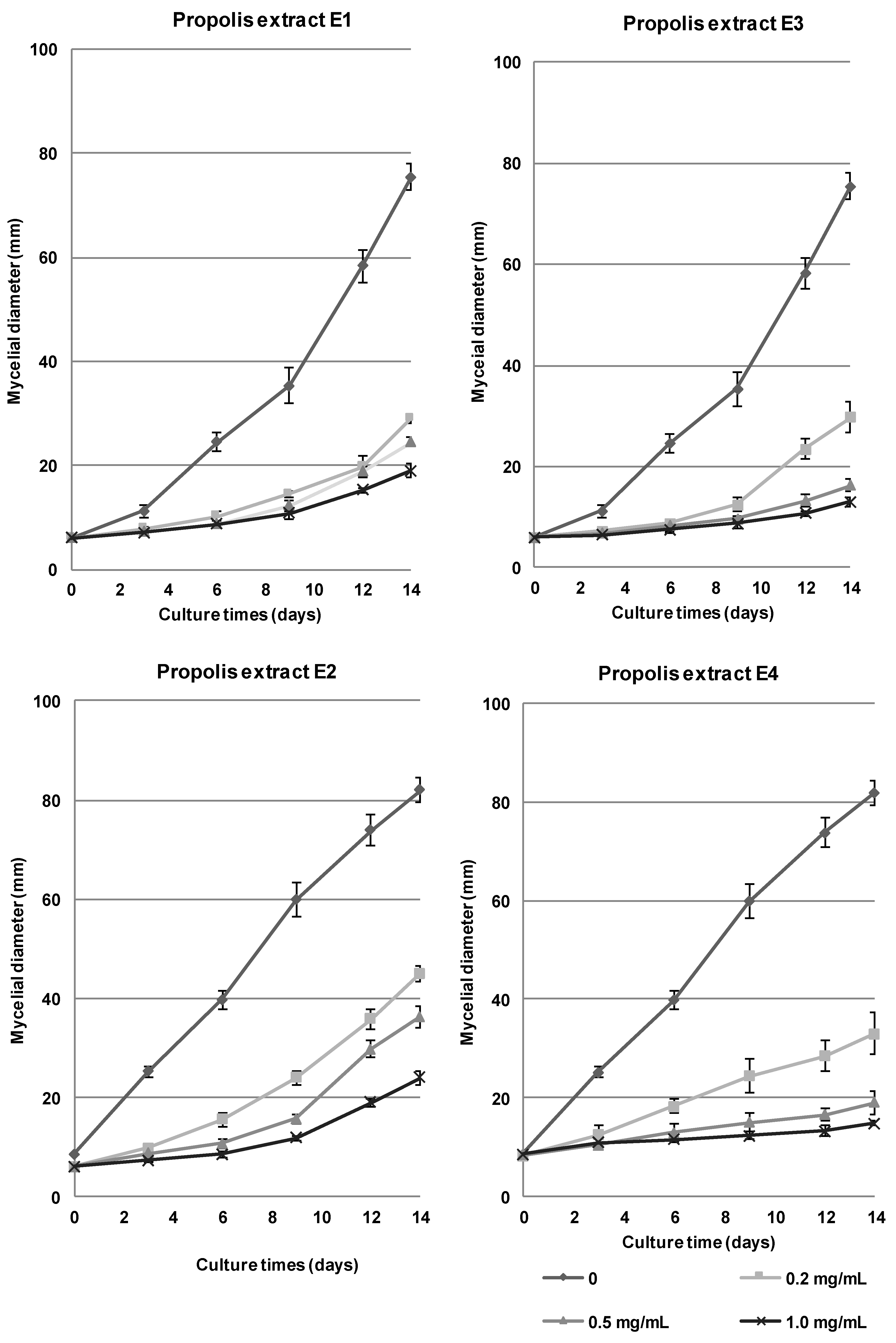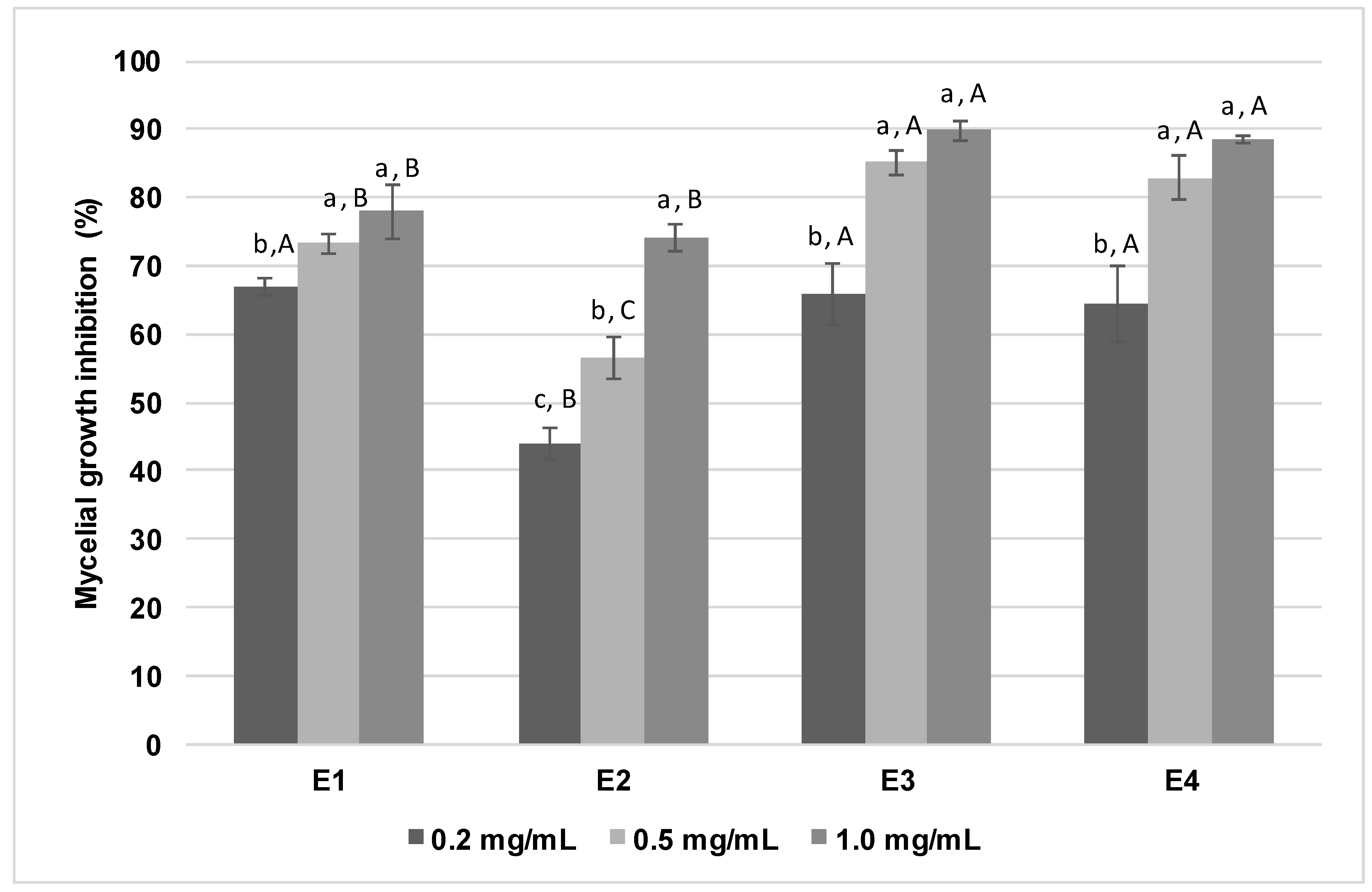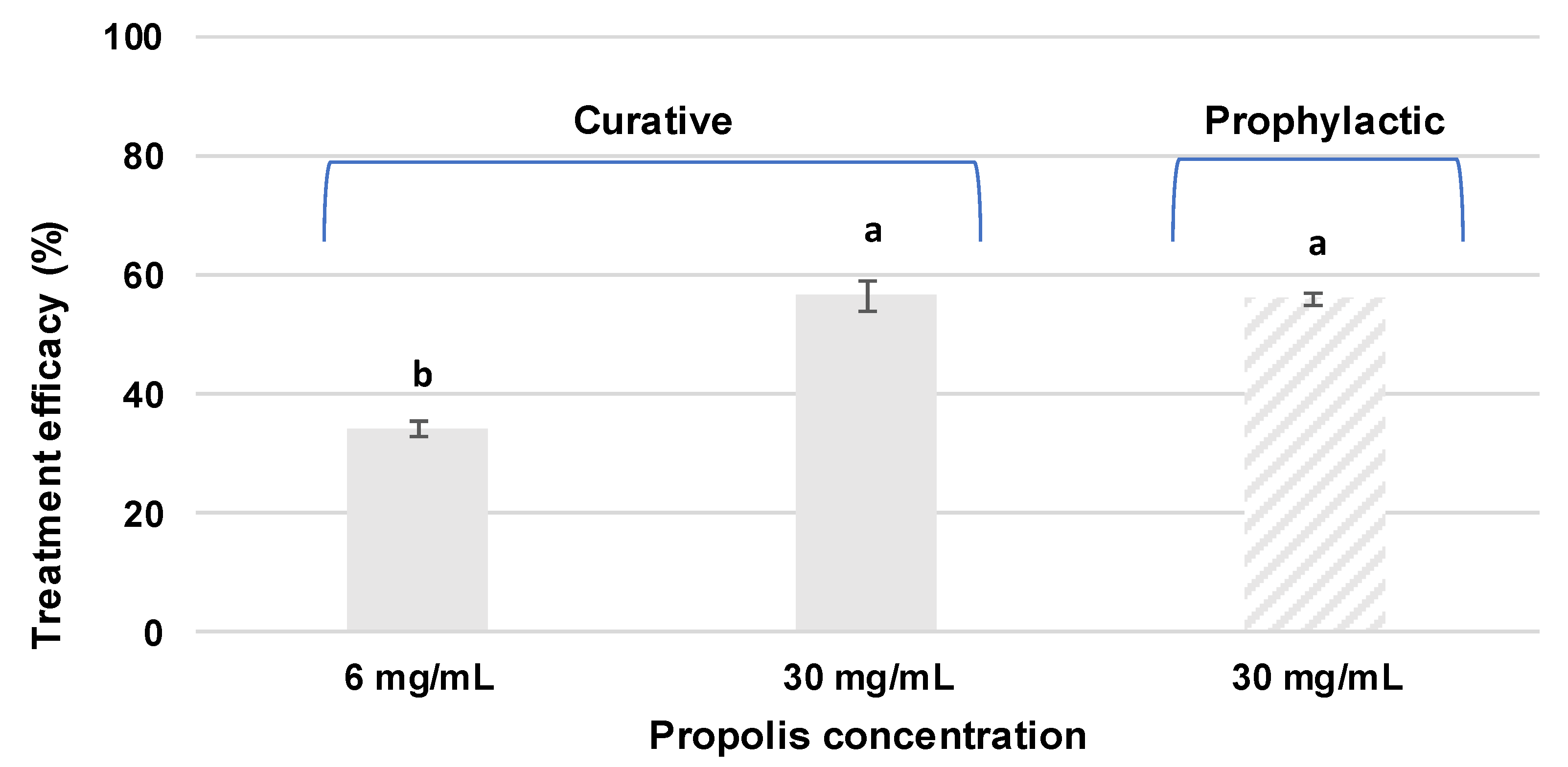Potential Application of Propolis Extracts to Control the Growth of Stemphylium vesicarium in “Rocha” Pear
Abstract
1. Introduction
2. Materials and Methods
2.1. Reagents
2.2. Propolis Samples and Extracts Preparation
2.3. Propolis Extracts Characterization
2.3.1. Determination of Propolis Total Phenolic Content
2.3.2. Ferric Reducing Antioxidant Power (FRAP) Assay
2.3.3. DPPH Radical-Scavenging Assay
2.4. In Vitro Antifungal Activity of Propolis Extracts Against Stemphylum vesicarium
2.5. In Vivo Antifungal Activity of Propolis Extracts Against Stemphylum vesicarium
2.6. Statistical Analysis
3. Results and Discussion
3.1. Propolis Extracts Characterization
3.2. In Vitro Antifungal Activity of Propolis Extracts Against Stemphylium vesicarium
3.3. In vivo Antifungal Activity of Propolis Extracts Against Stemphylium vesicarium
4. Conclusions
Author Contributions
Funding
Conflicts of Interest
References
- Diogo, E.; Sánchez, C.; Leão, M.; de Sousa, R. A Estenfiliose da Pereira Rocha em Portugal. Rev. Técnico-Cient. Agríc. 2017, 24, 46–48. [Google Scholar]
- Llorente, I.; Montesinos, E. Brown Spot of Pear: An emerging disease of economic importance Europe. Plant Dis. 2006, 90, 1368–1375. [Google Scholar] [CrossRef]
- Rossi, V.; Pattori, E. Inoculum reduction of Stemphylium vesicarium, the causal agent of brown spot of pear, through application of Trichoderma-based products. Biol. Control 2009, 49, 52–57. [Google Scholar] [CrossRef]
- Puig, M.; Moragrega, C.; Ruz, L.; Calderón, C.E.; Cazorla, F.M.; Montesinos, E.; Llorente, I. Interaction of antifungal peptide BP15 with Stemphylium vesicarium, the causal agent of brown spot of pear. Fungal Biol. 2016, 120, 61–71. [Google Scholar] [CrossRef]
- Moragrega, C.; Puig, M.; Ruz, L.; Montesinos, E.; Llorente, I. Epidemiological features and trends of brown spot of pear disease based on the diversity of pathogen populations and climate change effects. Phytopathology 2018, 108, 223–233. [Google Scholar] [CrossRef] [PubMed]
- Puig, M.; Moragrega, C.; Ruz, L.; Montesinos, E.; Llorente, I. Controlling brown spot of pear by a synthetic antimicrobial peptide under field conditions. Plant Dis. 2015, 99, 1816–1822. [Google Scholar] [CrossRef] [PubMed]
- Cappai, F.; De Franceschi, P.; Ciriani, A.; Collina, M.; Dondini, L. QTLs for susceptibility to Stemphylium vesicarium in pear. Mol. Breed. 2018, 38, 24. [Google Scholar] [CrossRef]
- Llorente, I.; Moragrega, C.; Ruz, L.; Montesinos, E. An update on control of brown spot of pear. Trees 2012, 6, 239–245. [Google Scholar] [CrossRef] [PubMed]
- Bankova, V.; de Castro, S.L.; Marcucci, M.C. Propolis: Recent advances in chemistry and plant origin. Apidologie 2000, 31, 3–15. [Google Scholar] [CrossRef]
- Falcão, S.I.; Freire, C.; Figueiredo, A.C.; Boas, M.V. The volatile composition of Portuguese propolis towards its origin discrimination. Rec. Nat. Prod. 2016, 10, 176. [Google Scholar]
- Marcucci, M.C. Propolis: Chemical composition, biological properties and therapeutic activity. Apidologie 1995, 26, 83–99. [Google Scholar] [CrossRef]
- Bankova, V. Chemical diversity of propolis and the problem of standardization. J. Ethnopharmacol. 2005, 100, 114–117. [Google Scholar] [CrossRef] [PubMed]
- Miguel, M.G.; Nunes, S.; Dandlen, S.A.; Cavaco, A.M.; Antunes, M.D. Phenols and antioxidant activity of hydro-alcoholic extracts of propolis from Algarve, South of Portugal. Food Chem. Toxicol. 2010, 48, 3418–3423. [Google Scholar] [CrossRef] [PubMed]
- Sforcin, J.M.; Bankova, V. Propolis: Is there a potential for the development of new drugs? J. Ethnopharmacol. 2011, 133, 253–260. [Google Scholar] [CrossRef]
- Banskota, A.H.; Tezuka, Y.; Kadota, S. Recent progress in pharmacological research of propolis. Phytother. Res. 2001, 15, 561–571. [Google Scholar] [CrossRef]
- Viuda-Martos, M.; Ruiz-Navajas, Y.; Fernández-López, J.; Pérez-Alvarez, J.A. Functional properties of honey, propolis, and royal jelly. J. Food Sci. 2008, 73, 117–125. [Google Scholar] [CrossRef]
- Meneses, E.A.; Durango, D.L.; Garcia, C.M. Antifungal activity against postharvest fungi by extracts from Colombian propolis. Quím. Nova 2009, 32, 2011–2017. [Google Scholar] [CrossRef]
- Boufadi, Y.M.; Soubhye, J.; Jean, N. Antimicrobial effects of six Algerian propolis extracts. Int. J. Food Sci. Technol. 2016, 51, 2613–2620. [Google Scholar] [CrossRef]
- Yang, S.; Peng, L.; Cheng, Y.; Chen, F.; Pan, S. Control of citrus green and blue molds by Chinese propolis. Food Sci. Biotechnol. 2010, 19, 1303–1308. [Google Scholar] [CrossRef]
- Soylu, E.M.; Özdemir, A.E.; Ertürk, E.; Şahinler, N. Antifungal activity of propolis against Penicillium Digitatum, causal agent of green mold of citrus fruits. In Proceedings of the First European Conference of Apidology ‘EurBee’, Udine, Italy, 19–23 September 2004. [Google Scholar]
- Soylu, E.M.; Özdemir, A.E.; Ertürk, E.; Şahinler, N.; Soylu, S. Chemical composition and antifungal activity of propolis against Penicillium digitatum. Asian J. Chem. 2008, 20, 4823–4830. [Google Scholar]
- Sánchez, C.; Duarte, P.; Vasilenko, P.; Santos, M.; Loebler, M.; Cruz, A.S.; Gonçalves, M. Potential application of Portuguese propolis to control blue mould disease in ‘Rocha’ pear. Acta Hortic. 2016, 1144, 359–364. [Google Scholar] [CrossRef]
- Loebler, M.; Sánchez, C.; Santos, M.; Vasilenko, P.; Duarte, M.P.; Cruz, A.; Gonçalves, M. Aplicação de extratos de própolis para conservação pós-colheita de morangos. Vida Rural. 2018, 1837, 38–40. [Google Scholar]
- Sánchez, C.; Loebler, M.; Santos, M.; Vasilenko, P.; Cruz, A.S.; Duarte, M.P.; Gonçalves, M. Aplicación de compuestos bioactivos para conservación postcosecha de fresas. Rev. Frutic. 2018, 61, 56–65. [Google Scholar]
- Bankova, V.; Popova, M.; Trusheva, B. New emerging fields of application of propolis. Maced. J. Chem. Chem. Eng. 2016, 35, 1–11. [Google Scholar] [CrossRef]
- Koşar, M.; Göger, F.; Başer, K.H.C. In vitro antioxidant properties and phenolic composition of Salvia virgata Jacq. from Turkey. J. Agric. Food Chem. 2008, 56, 2369–2374. [Google Scholar] [CrossRef]
- Lima, K.; Silva, O.; Figueira, M.E.; Pires, C.; Cruz, D.; Gomes, S.; Maurício, E.M.; Duarte, M.P. Influence of the in vitro gastrointestinal digestion on the antioxidant activity of Artemisia gorgonum Webb and Hyptis pectinata (L.) Poit. infusions from Cape Verde. Food Res. Int. 2019, 115, 150–159. [Google Scholar] [CrossRef]
- Kedare, S.B.; Singh, R.P. Genesis and development of DPPH method of antioxidant assay. J. Food Sci. Technol. 2011, 48, 412–422. [Google Scholar] [CrossRef]
- Jug, M.; Končić, M.Z.; Kosalec, I. Modulation of antioxidant, chelating and antimicrobial activity of poplar chemo-type propolis by extraction procures. LWT-Food Sci. Technol. 2014, 57, 530–537. [Google Scholar] [CrossRef]
- Moreira, L.; Dias, L.G.; Pereira, J.A.; Estevinho, L. Antioxidant properties, total phenols and pollen analysis of propolis samples from Portugal. Food Chem. Toxicol. 2008, 46, 3482–3485. [Google Scholar] [CrossRef]
- Silva, J.C.; Rodrigues, S.; Feás, X.; Estevinho, L.M. Antimicrobial activity, phenolic profile and role in the inflammation of propolis. Food Chem. Toxicol. 2012, 50, 1790–1795. [Google Scholar] [CrossRef]
- Dias, L.G.; Pereira, A.P.; Estevinho, L.M. Comparative study of different Portuguese samples of propolis: Pollinic, sensorial, physicochemical, microbiological characterization and antibacterial activity. Food Chem. Toxicol. 2012, 50, 4246–4253. [Google Scholar] [CrossRef] [PubMed]
- da Silva, J.F.M.; de Souza, M.C.; Matta, S.R.; de Andrade, M.R.; Vidal, F.V.N. Correlation analysis between phenolic levels of Brazilian propolis extracts and their antimicrobial and antioxidant activities. Food Chem. 2006, 99, 431–435. [Google Scholar] [CrossRef]
- Chaillou, L.L.; Nazareno, M.A. Bioactivity of propolis from Santiago del Estero, Argentina, related to their chemical composition. LWT-Food Sci. Technol. 2009, 42, 1422–1427. [Google Scholar] [CrossRef]
- Falcão, S.I.; Tomás, A.; Vale, N.; Gomes, P.; Freire, C.; Vilas-Boas, M. Phenolic quantification and botanical origin of Portuguese propolis. Ind. Crop. Prod. 2013, 49, 805–812. [Google Scholar] [CrossRef]
- Pobiega, K.; Kraśniewska, K.; Derewiaka, D.; Gniewosz, M. Comparison of the antimicrobial activity of propolis extracts obtained by means of various extraction methods. J. Food Sci. Technol. 2019, 56, 5386–5395. [Google Scholar] [CrossRef]
- de Lima, G.G.; de Souza, R.O.; Bozzi, A.D.; Poplawska, M.A.; Devine, D.M.; Nugent, M.J. Extraction method plays critical role in antibacterial activity of propolis-loaded hydrogels. J. Pharm. Sci. 2016, 105, 1248–1257. [Google Scholar] [CrossRef]
- Silici, S.; Koc, N.A.; Ayangil, D.; Canaya, S. Antifungal activities of propolis collected by different races of honeybees against yeasts isolated from patients with superficial mycoses. J. Pharmacol. Sci. 2005, 99, 39–44. [Google Scholar] [CrossRef]
- Najafi, M.F.; Vahedy, F.; Seyyedin, M.; Jomehzadeh, H.R.; Bozary, K. Effect of the water extracts of propolis on stimulation and inhibition of different cells. Cytotechnology 2007, 54, 49–56. [Google Scholar] [CrossRef]
- Campana, R.; Patrone, V.; Franzini, I.T.; Diamantini, G.; Vittoria, E.; Baffone, W. Antimicrobial activity of two propolis samples against human Campylobacter jejuni. J. Med. Food 2009, 12, 1050–1056. [Google Scholar] [CrossRef]
- Falcão, S.I.; Vale, N.; Cos, P.; Gomes, P.; Freire, C.; Maes, L.; Vilas-Boas, M. In vitro evaluation of Portuguese propolis and floral sources for antiprotozoal, antibacterial and antifungal activity. Phytother. Res. 2014, 28, 437–443. [Google Scholar] [CrossRef]
- Yang, S.Z.; Peng, L.T.; Su, X.J.; Chen, F.; Cheng, Y.J.; Fan, G.; Pan, S.Y. Bioassay-guided isolation and identification of antifungal components from propolis against Penicillium italicum. Food Chem. 2011, 127, 210–215. [Google Scholar] [CrossRef]
- Cushnie, T.P.T.; Lamb, A.J. Antimicrobial activity of flavonoids. Int. J. Antimicrob. Agents 2005, 26, 343–356. [Google Scholar] [CrossRef] [PubMed]
- Teodoro, G.R.; Ellepola, K.; Seneviratne, C.J.; Koga-Ito, C.Y. Potential use of phenolic acids as anti-Candida agents: A review. Front. Microbiol. 2015, 6, 1420. [Google Scholar] [CrossRef] [PubMed]
- Peng, L.; Yang, S.; Cheng, Y.J.; Chen, F.; Pan, S.; Fan, G. Antifungal activity and action mode of pinocembrin from propolis against Penicillium italicum. Food Sci. Biotechnol. 2012, 21, 1533–1539. [Google Scholar] [CrossRef]
- Alberoni, G.; Cavallini, D.; Collina, M.; Brunelli, A. Characterisation of the first Stemphylium vesicarium isolates resistant to strobilurins in Italian pear orchards. Eur. J. Plant Pathol. 2010, 126, 453–457. [Google Scholar] [CrossRef]
- Matny, O.N. Efficacy evaluation of Iraqi propolis against gray mold of stored orange caused by Penicillium digitatum. Plant Pathol. J. 2015, 14, 153–157. [Google Scholar] [CrossRef]
- Pereira, C.S.; Guimarães, R.J.; Pozza, E.A.; da Silva, A.A. Controle da cercosporiose e da ferrugem do cafeeiro com extrato etanólico de própolis. Ceres 2015, 55, 369–376. [Google Scholar]
- Ali, A.; Chow, W.L.; Zahid, N.; Ong, M.K. Efficacy of propolis and cinnamon oil coating in controlling post-harvest anthracnose and quality of chilli (Capsicum annuum L.) during cold storage. Food Bioprocess Technol. 2014, 7, 2742–2748. [Google Scholar] [CrossRef]
- Embaby, E.M.; Hazaa, M.M.; El-Dougdoug, K.H.; Monem, A.M.O.; Abd-Elgalil, M.M.; Elwan, E.E. Control Apple Fruit Decay by Using ‘Ethanol Extract of Propolis’(EEP). IJAMS 2019, 4, 1–11. [Google Scholar]
- Abdel-Hafez, S.I.; Abo-Elyousr, K.A.; Abdel-Rahim, I.R. Effectiveness of plant extracts to control purple blotch and Stemphylium blight diseases of onion (Allium cepa L.) in Assiut, Egypt. Arch. Phytopathol. Plant Prot. 2014, 47, 377–387. [Google Scholar] [CrossRef]
- Puig, M.; Moragrega, C.; Ruz, L.; Montesinos, E.; Llorente, I. Postinfection activity of synthetic antimicrobial peptides against Stemphylium vesicarium in pear. Phytopathology 2014, 104, 1192–1200. [Google Scholar] [CrossRef] [PubMed]
- Montesinos, E.; Llorente, I.; Moragrega, C.; Bonaterra, A.; Cervantes, J.; Vilardell, P. Desarrollo y evaluación a escala productiva de un sistema de control racional de la estemfiliosis (Stemphylium vesicarium) del peral. Frutic. Prof. 1996, 78, 96–104. [Google Scholar]




| Propolis Extract | Phenolic Compounds | DPPH | FRAP |
|---|---|---|---|
| (mg GAE/g Dry Extract) | (mg TE/g Dry Extract) | (mmol Fe2+/g Dry Extract) | |
| E1 | 275.0 ± 7.1 b | 318.3 ± 3.5 a | 3.7 ± 0.1 c |
| E2 | 300.0 ± 3.8 a | 313.5 ± 3.1 a | 4.6 ± 0.1 a |
| E3 | 298.0 ± 5.0 a | 281.5 ± 2.4 b | 4.1± 0.1 b |
| E4 | 313.7 ± 12.5 a | 258.1 ± 1.8 c | 4.0 ± 0.2 b |
© 2020 by the authors. Licensee MDPI, Basel, Switzerland. This article is an open access article distributed under the terms and conditions of the Creative Commons Attribution (CC BY) license (http://creativecommons.org/licenses/by/4.0/).
Share and Cite
Loebler, M.; Sánchez, C.; Muchagato Maurício, E.; Diogo, E.; Santos, M.; Vasilenko, P.; Cruz, A.S.; Mendes, B.; Gonçalves, M.; Duarte, M.P. Potential Application of Propolis Extracts to Control the Growth of Stemphylium vesicarium in “Rocha” Pear. Appl. Sci. 2020, 10, 1990. https://doi.org/10.3390/app10061990
Loebler M, Sánchez C, Muchagato Maurício E, Diogo E, Santos M, Vasilenko P, Cruz AS, Mendes B, Gonçalves M, Duarte MP. Potential Application of Propolis Extracts to Control the Growth of Stemphylium vesicarium in “Rocha” Pear. Applied Sciences. 2020; 10(6):1990. https://doi.org/10.3390/app10061990
Chicago/Turabian StyleLoebler, Marcella, Claudia Sánchez, Elisabete Muchagato Maurício, Eugénio Diogo, Mário Santos, Paula Vasilenko, Ana Sofia Cruz, Benilde Mendes, Margarida Gonçalves, and Maria Paula Duarte. 2020. "Potential Application of Propolis Extracts to Control the Growth of Stemphylium vesicarium in “Rocha” Pear" Applied Sciences 10, no. 6: 1990. https://doi.org/10.3390/app10061990
APA StyleLoebler, M., Sánchez, C., Muchagato Maurício, E., Diogo, E., Santos, M., Vasilenko, P., Cruz, A. S., Mendes, B., Gonçalves, M., & Duarte, M. P. (2020). Potential Application of Propolis Extracts to Control the Growth of Stemphylium vesicarium in “Rocha” Pear. Applied Sciences, 10(6), 1990. https://doi.org/10.3390/app10061990






